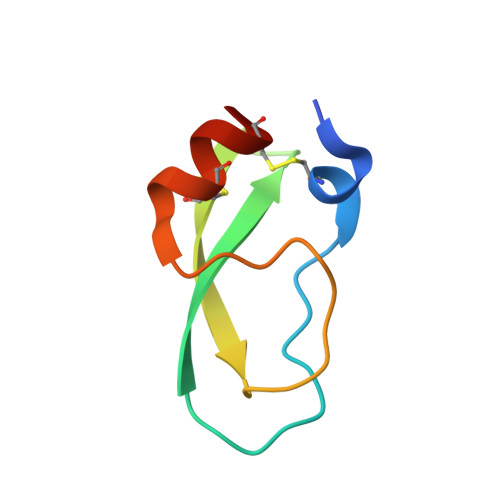Structure of conkunitzin-S1, a neurotoxin and Kunitz-fold disulfide variant from cone snail.
Dy, C.Y., Buczek, P., Imperial, J.S., Bulaj, G., Horvath, M.P.(2006) Acta Crystallogr D Biol Crystallogr 62: 980-990
- PubMed: 16929098
- DOI: https://doi.org/10.1107/S0907444906021123
- Primary Citation of Related Structures:
1Y62 - PubMed Abstract:
Cone snails (Conus) are predatory marine mollusks that immobilize prey with venom containing 50-200 neurotoxic polypeptides. Most of these polypeptides are small disulfide-rich conotoxins that can be classified into families according to their respective ion-channel targets and patterns of cysteine-cysteine disulfides. Conkunitzin-S1, a potassium-channel pore-blocking toxin isolated from C. striatus venom, is a member of a newly defined conotoxin family with sequence homology to Kunitz-fold proteins such as alpha-dendrotoxin and bovine pancreatic trypsin inhibitor (BPTI). While conkunitzin-S1 and alpha-dendrotoxin are 42% identical in amino-acid sequence, conkunitzin-S1 has only four of the six cysteines normally found in Kunitz proteins. Here, the crystal structure of conkunitzin-S1 is reported. Conkunitzin-S1 adopts the canonical 3(10)-beta-beta-alpha Kunitz fold complete with additional distinguishing structural features including two completely buried water molecules. The crystal structure, although completely consistent with previously reported NMR distance restraints, provides a greater degree of precision for atomic coordinates, especially for S atoms and buried solvent molecules. The region normally cross-linked by cysteines II and IV in other Kunitz proteins retains a network of hydrogen bonds and van der Waals interactions comparable to those found in alpha-dendrotoxin and BPTI. In conkunitzin-S1, glycine occupies the sequence position normally reserved for cysteine II and the special steric properties of glycine allow additional van der Waals contacts with the glutamine residue substituting for cysteine IV. Evolution has thus defrayed the cost of losing a disulfide bond by augmenting and optimizing weaker yet nonetheless effective non-covalent interactions.
Organizational Affiliation:
Biology, University of Utah, 257 S 1400 E, Salt Lake City, Utah 84112-0840, USA.















